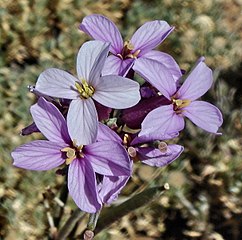
Euphorbia canariensis, commonly known as the Canary Island spurge, Hercules club or in Spanish cardón, is a succulent member of the genus Euphorbia and family Euphorbiaceae endemic to the Canary Islands. It is the plant symbol of the island of Gran Canaria.

Argyranthemum frutescens, known as Paris daisy, marguerite or marguerite daisy, is a perennial plant known for its flowers. It is native to the Canary Islands. Hybrids derived from this species are widely cultivated as ornamental plants in private gardens and public parks in many countries, and have naturalized in Italy and southern California. There are many cultivars, but the most common has white petals.
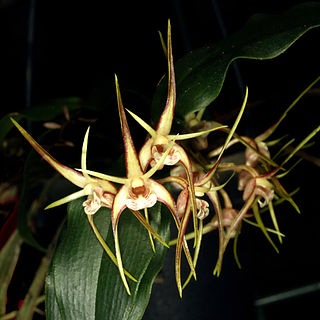
Dendrobium tetragonum, commonly known as the tree spider orchid, is a variable species of epiphytic or lithophytic orchid endemic to eastern Australia. Tree spider orchids are unusual in having pendulous pseudobulbs that are thin and wiry near the base then expand into a fleshy, four-sided upper section before tapering at the tip. There are only a few thin but leathery leaves at the end of the pseudobulbs and up to five flowers on relatively short flowering stems. To allow for the variations in the species there are five subspecies and a variety, some with a unique common name.

Geranium reuteri, the giant geranium, is a species of flowering plant in the family Geraniaceae, native to the Canary Islands and Madeira. It was known for many years under the name Geranium canariense. In Spanish, it is called pata de gallo.

Arisarum vulgare, common name the friar's cowl or larus, is an herbaceous, perennial, with an underground rhizome plant in the genus Arisarum belonging to the family Araceae.
Cistus ocreatus is a shrubby species of flowering plant in the family Cistaceae, with purple-pink flowers. It is sometimes treated as synonymous with Cistus symphytifolius or as its subspecies C. symphytifolius subsp. leucophyllus. Its name is sometimes spelt Cistus ochreatus. It is endemic to Gran Canaria in the Canary Islands.

Periploca laevigata is a species of flowering plant in the family Apocynaceae, native to the Canary Islands, the Savage Islands and Cape Verde.
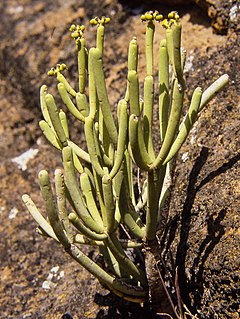
Euphorbia aphylla is a species of flowering plant in the family Euphorbiaceae. It is native to the Canary Islands. It was first described in 1809.

Sonchus congestus is a species of flowering plant in the family Asteraceae. It is endemic to the Canary Islands.
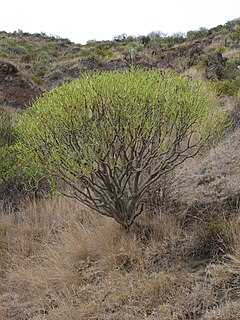
Euphorbia lamarckii is a species of flowering plant in the family Euphorbiaceae, native to the western Canary Islands. It resembles Euphorbia regis-jubae, with which it has been confused. Both have been called Euphorbia obtusifolia.
The scientific name Euphorbia obtusifolia has been used for at least three species of Euphorbia:

Euphorbia regis-jubae is a species of flowering plant in the family Euphorbiaceae, native to the eastern Canary Islands, western Morocco, north-western Western Sahara. In Spanish, it is known as tabaiba morisca. It has often been confused with Euphorbia lamarckii.

Aeonium aureum is a species of flowering plant in the family Crassulaceae, native to the Canary Islands. It has very short stems, usually with several leaf rosettes. The grey-green leaves are tightly packed and fleshy. The bright yellow flowers are produced on leafy stems, and are up to 25 mm (1 in) across.

Habenaria tridactylites is a species of flowering plant in the family Orchidaceae, native to the Canary Islands. It was first described by John Lindley in 1835.

Nanorrhinum scoparium, synonym Kickxia scoparia, is a species of flowering plant in the family Plantaginaceae.

Retama raetam is a species of flowering plant in the family Fabaceae, native to northern Africa from the Western Sahara to Sudan, Sicily, the Sinai Peninsula, Palestine and Saudi Arabia, and widely naturalized elsewhere.
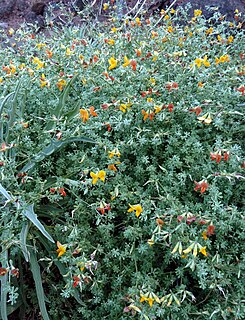
Lotus glaucus is a species of flowering plant in the family Fabaceae, native to Madeira and the Salvage Islands. It is a perennial herbaceous plant with leaves made up of five leaflets. Its flowers are usually orange on opening. Lotus tenellus is included in a more broadly circumscribed L. glaucus by some authors, which extends its distribution to the Canary Islands.

Lotus tenellus is a species of flowering plant in the family Fabaceae, native to the Canary Islands. Some authors have included L. tenellus in Lotus glaucus, a species found in Madeira and the Salvage Islands. L. leptophyllus may be treated as a synonym of L. tenellus or as a separate species. L. tenellus has yellow flowers, with usually no more than three flowers in each flower head (umbel). Its leaves are made up of five leaflets.

Salix pedicellata is a species of willow. It is a shrub or small tree to about 6–8 m tall, native around the Mediterranean Sea from Portugal to Lebanon and Syria in the north and from the Canary Islands to Tunisia in the south. Salix canariensis may be treated as a subspecies of S. pedicellata.

Garden marguerites, also known as marguerite daisies, are cultivars of plants in the subtribe Glebionidinae of the family Asteraceae, the great majority being hybrids created in cultivation. One of the genera belonging to the subtribe, Argyranthemum, was introduced into cultivation from the Canary Islands in the 18th century, and modern cultivars are mostly sold and grown under the genus name Argyranthemum or the species name Argyranthemum frutescens, although many are actually intergeneric hybrids. The first such hybrids involved species now placed in the genus Glebionis, but other crosses within the subtribe are known. Breeding has aimed at introducing flower heads in varied colours and shapes while retaining the shrubby habit of Argyranthemum. Garden marguerites are used as summer bedding or grown in containers. Most are only half-hardy. They can be trained into shapes such as pyramids or grown as standards.

